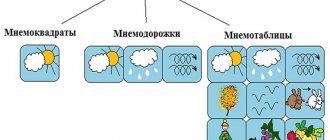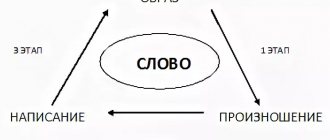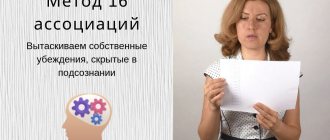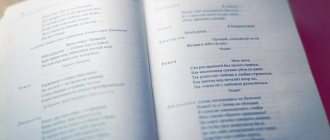Photos: Depositphotos / Illustration: Yulia Zamzhitskaya
“Scarlet Waltz. Flies from the ravine Copper farewells, grass finale. Gray clay, anxiety, ceremony, silence. The slate depths of leaf fall Fall into giant arcades..."
No, this is not a masterpiece of Silver Age poetry, but a mnemonic rule for remembering amino acids. The words in the poem begin with the same letter as the name of the amino acid: from alanine to histidine to arginine - yes, these are the names of amino acids. It becomes clear why memorization techniques were needed and that “slate” is not the worst word.
Every teacher has his own favorite mnemonic rules: they are learned from colleagues, invented together with students, and some are passed down from generation to generation for decades. Let's remember the techniques with which you can move away from cramming rules and concepts.
Introduction
Have you decided to study mnemonics? First, let's try to figure out what kind of science this is. If we turn to the encyclopedia, we get the following definition: Mnemonics (or mnemonics) - from the Greek. mnemonikon - the art of memorization, means a set of techniques and methods that facilitate memorization and increase memory capacity through the formation of artificial associations. In simple terms, these are special techniques for memorizing new information, which in turn is encoded into an image and linked through associations to existing information. For example, you and I have all known the 7 colors of the rainbow and their sequence since childhood. Remember the famous memory stick?
Every hunter wants to know where the pheasant is going This remembered almost the first time, since it is just one sentence . From the first letters we can easily remember the main colors of the rainbow: Red , Orange , Yellow , Green , Blue , Blue , Violet .
In general, mnemonic techniques are good for remembering accurate information. Therefore, the more complex the information from the point of view of normal memory, the easier it is to remember using mnemonic methods. Let's see which sequence of numbers is easy to remember: 830948362 or 123456789 or 194119454? Probably the one with which you have associations: counting in order (123...), a memorable date (1941-1945) or a favorite number, birthday, your car number, etc.
The main “secret” of mnemonics is very simple and well known. When a person connects several visual images in his imagination, the brain records this relationship. And later, when recalling one of the images of this association, the brain reproduces all previously connected images. Thus, using this mechanism, you can remember a telephone number, a historical date, or an entire chronological table. Possession of mnemonics skills allows mnemonists (people who professionally engage in mnemonics) to memorize huge sequences of numbers. For example, 20,000 decimal places of Pi (3.141592653589793238...)
Let us give you some real examples of phenomenal memory. Thus, a 26-year-old Chinese telephone operator from Harbin remembered 15,000 telephone numbers from 10 cities in China.
Dominic O'Brien from Great Britain memorized the sequence of cards in 40 different decks and made only one mistake. Moreover, each card was shown to him only once. He set the record on November 26, 1993 at the BBC studio in Elstree (UK). On March 25, 1994, at the presentation of the Guinness World Records, Dominic memorized a sequence of cards in one deck in 43.59 seconds (demonstrating a memorization speed of 0.84 seconds per card).
Twenty-three-year-old Indian S. Mahedevan, a psychology student from Mangalore, set a world memory record in memorizing digital information. In three hours and thirty-nine minutes, he memorized and repeated 31,811 numbers by heart. The previous record was 28,013 digits in 9 hours and 14 minutes. If we assume that the memorization of numbers was carried out on the basis of dividing a series into three-digit numbers-images, then in the first case the speed of memorization was 1.2 seconds, and in the second - 3.6 seconds per visual image, in which three numbers are encoded at once.
What is striking about these records is the high speed of memorization, i.e. the average time spent on memorizing one unit of information. Each number, when memorized, has its own image, defined by them once and for all, for example: 1 - hedgehog, 2 - poison, 3 - ear, 4 - check, 5 - nickel, etc. When you need to remember a sequence of numbers: 51342. Mnemonists instantly translate it into images: nickel-hedgehog-ear-check-poison, They associate it into an association: a hedgehog is depicted on the nickel, the hedgehog has a big ear, a check sticks out of the ear, the check is saturated with poison and remember it . The fact is that it is much more convenient and easier for consciousness to work with images than with abstract symbols and numbers.
Let's try to work with one of the mnemonic methods - “chain”. This method works this way: images are associated in pairs. In each pair, the images should be approximately the same size. You form a connection between the first and second image, and then remove the first image from consciousness by transferring attention to the second. After this, a relationship is formed between the second and third image, etc.
Let’s look at the “chain” method using an example: book - chair - window - light bulb, take the 1st and 2nd images and connect them into an association (the book lies on the chair). Then the 2nd and 3rd images are connected (the chair broke the window) and the 3rd and 4th (the light bulb is on in the window)
CLEAR DEMONSTRATION OF THE CHAIN METHOD
1) the book is lying on the chair; 2) the chair broke the window; 3) a light is on in the window.
Figure 1. Remember using the Chain method: book-chair-window-light bulb (horizontal association)
RECOMMENDATIONS:
— The sizes of the images are approximately the same in each pair. - Always form connections according to a certain system. For example, if the association is horizontal, place the first image on the left (Figure 1); if the association is vertical, place the first image on the top (Figure 2). When recalling, read the images in the same order. — Present the images brightly, colorfully, three-dimensionally. — The connections between images can be fantastic. For example, a chair looks out the window. This helps memorization.
Figure 2. Remember using the Chain method: book-chair-window-light bulb (vertical association)
Let's try to understand why we need mnemonics?
1. If you need to remember a large amount of information, then mnemonics will be useful to you. 2. If you want to be sure of the correctness and accuracy of the memorized material, then you cannot do without mnemonics. 3. If you are already over 25 and something has happened to my memory, then mnemonics will help here too. 4. Finally, mnemonics are a very good exercise for the brain.
Warning!
But, there is one thing. To master mnemonics you will need to train. You need to master a number of techniques and practice them many times. In terms of labor costs, mastering mnemonics can be compared with mastering a foreign language, up to an average or below average level. If you want to try to master mnemonics, then go ahead, we will help you with this, and if not, then we will simply wish you all the best!
Efficiency[edit]
Academic research into the use of mnemonics has shown their effectiveness. In one such experiment, subjects of different ages who used mnemonic techniques to learn new vocabulary outperformed control groups who used contextual learning and free learning styles. [25]
Mnemonics vary in effectiveness for several groups, from young children to older adults. Mnemonic teaching strategies require teachers' time and resources to develop creative and effective devices. The simplest and most creative mnemonics are usually the most effective for learning. In the classroom, mnemonic devices must be used at appropriate times in the instructional sequence to achieve their maximum effectiveness. [26]
Mnemonics appeared to be more effective for groups of people who struggled or had weak long-term memory, like older people. Five years after mnemonic training, the research team followed 112 community-dwelling older adults aged 60 years and older. Delayed word list recall was assessed before and immediately after mnemonic training, as well as at a 5-year follow-up. Overall, there was no significant difference between word retention pretraining and follow-up. However, pre-training performance increases both immediate post-training performance and mnemonic predictive performance at follow-up. Individuals who self-reported using mnemonics showed the highest performance overall, with significantly higher scores than before training. The findings suggest that mnemonics training has long-term benefits for some older adults, especially those who continue to use mnemonics.[27]
This contrasts with surveys of medical students in which only approximately 20% frequently use mnemonic abbreviations. [28]
In humans, the aging process particularly affects the medial temporal lobe and hippocampus, where episodic memory is synthesized. Episodic memory stores information about elements, objects, or characteristics with spatiotemporal context. Because mnemonics help you remember spatial or physical information better than more abstract forms, their effect may vary depending on the person's age and how well the medial temporal lobe and hippocampus are functioning.
This may be further explained by one recent study that indicates a general memory deficit for spatial location in older adults (mean age 69.7 with a standard deviation of 7.4 years) compared to younger adults (mean age 21.7 with a standard deviation of 4 ,2 years). At first, the difference in target recognition was negligible.
The researchers then divided the older adults into two groups: healthy older adults and older adults with disabilities, according to neuropsychological testing. When separated by age group, there was a clear deficit in target recognition in older adults with disabilities compared to both younger adults and older healthy adults. This also confirms the different effectiveness of mnemonics in different age groups. [29]
Moreover, various studies have been previously conducted with the same idea, which yielded results similar to those of Reagh et al. in a verbal mnemonic recognition task. [thirty]
Research (notably "The Magic Number Seven, Plus or Minus Two") has shown that adults' short-term memory can only contain a limited number of items; grouping items into larger chunks, such as mnemonics, may be part of what allows a greater overall amount of information to be stored in short-term memory, which in turn may help create long-term memories. [ citation needed
] [31]
Associations
Any memorization or memorization presupposes the establishment of appropriate neural connections, or associations. Psychologists understand association as a natural connection between individual events, facts, objects or phenomena reflected in consciousness and fixed in memory. If there is an associative connection between mental phenomena. A and B, the emergence in a person’s consciousness of phenomenon A naturally entails the appearance in the consciousness of phenomenon B. There is also a stable phrase “remember by association” enshrined in the language. This means that stimulus A causes a reaction B in the brain. For example, a familiar melody evokes a memory of a movie or the words of a song. Photography evokes memories of past events. Mnemonics uses the same terminology, but the interpretation of concepts differs from those generally accepted in psychology. “Remember by association” - in mnemonics we can say the same thing, but we need to understand this as “remember a connection previously created in the brain.” Moreover, the connection could be created naturally (involuntarily) or the connection could be created specifically, consciously. Let's try to figure it out. Natural association is the automatic fixation of connections between objects in the surrounding world. For example, if we see a vase of flowers on the window, then a natural combination of connected images immediately arises in our heads: WINDOW-VASE-FLOWERS. This connection is remembered by the brain without our conscious participation. For example, when a car is repeatedly perceived, the natural association “car” is retained in the brain. This is an image consisting of several other images: the car body, wheels, hood, roof, steering wheel, trunk, number... Or the image of the “entrance door” consists of several sub-images: the door itself, the peephole, the number plate, the handle, the lock. Natural associations are actively used in mnemonics (Cicero's method, free association method, memorizing photographs and illustrations). An artificial association (or simply an association) is a visual image to which other images are consciously (artificially) attached. In association, they distinguish: the basis of the association (a whole image that includes other images - parts of the whole image) and elements of the association - images associated with parts of the whole image. The brain remembers these images as one picture. You can connect from two to five images simultaneously into an artificial association. Roughly speaking, an artificial association is similar to a Christmas tree with Christmas tree decorations. Where the Christmas tree is the main piece of information (the basis of the association), and Christmas tree decorations (other pieces of information) are elements of the association.
Mnemonic rules
Phenomenal memory - what is it, methods for developing information memorization
The essence of mnemonics comes down to the creation and connection of visual images. There are a number of rules by which they are formed:
- Images must be large. If we imagine that the imagination is a screen, then the imagined image should occupy its entire area.
- The image must be detailed. If you imagine a tree, then you need to consider every part of it: crown, bark, roots, every leaf. The more details are presented, the more neurons are activated in the brain, and the more likely it is that the picture will be stored in the head.
- The image should be colorful, ideally multi-colored.
To strengthen the skills of creating images that comply with these rules, there are special applications. You can practice these skills on your own. All mnemonic memorization techniques in psychology are based on these rules.
The main operation with associations is connecting images.
We imitate the natural process of perception followed by memorization and in our imagination we can combine several images. The brain then remembers the relationship between them. And then from one of these images he can recreate the entire picture. The operation “connecting images” is a kind of switch for the memorization mechanism.
In this case, it is necessary to form THREE SEPARATE CONNECTIONS. To do this, the necessary images are connected in the imagination and held together for about 3-6 seconds.
Images of abstract concepts
Usually it is not a problem to imagine images of things and objects. When you say “cup,” you see your favorite cup, which has a shape, color, and weight. “Road” will conjure up a section of road that is familiar to you. But what to do with abstract concepts that have no substantive embodiment, such as “consent,” “obligation,” or “suggestion”? There are two methods for recoding such concepts into images. The first is based on consonance. You choose a word or words that sound similar to the one you want to remember. Then you encode exactly this consonant word into an image.
The second technique uses symbolic imagination: you select a specific symbol image intuitively so that it expresses an abstract concept. This symbol may be generally accepted, or it may be understandable only to you. “Consent” is reminiscent of voices sounding in unison. The image of the choir is easy to imagine visually. “Obligation” is consonant with a wagon train that must be dragged along as a burden of obligations. “Suggestion” can be imagined as a tall snowdrift—the first three letters are often enough to build the association.
If you want to use symbols, "agreement" can be thought of as a firm handshake. Or like the Egyptian obelisk on the Place de la Concorde in Paris. The “commitment” can be presented in the form of an official document with a stamp. “Suggestion” can be symbolized by a stage hypnotist in a turban and a cloak with a red lining. Associations and symbols are very individual. A connoisseur of the Middle Ages associates the word “suggestion” with the name of Abbot Suger, who lived in the 11th–12th centuries and is known as the designer of the Gothic temple of Saint-Denis in the suburbs of Paris. The broader a person’s horizons, the easier it is for him to select associations and remember new things.
Exercise
Take a dictionary of terms in a field of knowledge that is unfamiliar to you: technology, philosophy or psychology. Open it at random and select images for the words you encounter, using phonetic and symbolic associations.
Rules for the formation of associations
There are several basic rules for accurately forming associations. Let's look at them: 1. Imagine visual images clear and concrete in space at a distance of about one meter from you. It doesn’t matter whether your eyes are open or closed. But most experienced mnemonists prefer to form associations with their eyes open, focusing their gaze on a plain, smooth surface. 2. Visualize visual images in a fairly large size so that you can reduce them (remove them) and enlarge them (zoom them closer). 3. Connect visual images so that they can be outlined with a solid continuous line in a circle. That is, all images in the association must be in contact with each other. 4. Form an association so that all visual images are clearly visible to you. You cannot hide images within each other or one after another. 5. When you create an association, your visual images may be in motion. But after you have connected them, stop (fix) the picture and focus your attention on it. 6. The visual images you create can have a different character (be sad or happy, good or evil). In fact, this does not affect the memorization process, but the “brighter” the character of the image, the better. 7. To facilitate the process of connecting images, you can adjust them to each other in different ways (rotate, twist, zoom in, move out).
Links[edit]
- Sones, Catherine; Stevenson, Angus; Hawker, Sarah, ed. (March 29, 2006). Concise Oxford English Dictionary (computer program):
entry on mnemonics (11th ed.). Oxford University Press. - μνημονικός. Liddell, Henry George; Scott, Robert; Greek-English Lexicon
at the Perseus Project - μνήμη. Liddell, Henry George; Scott, Robert; Greek-English Lexicon
at the Perseus Project - Carlson, Neil; and others. (March 2010). Psychology is the science of behavior
. Pearson Canada, United States of America. paragraph 245. ISBN 978-0-205-64524-4. - ^ a b c d
One or more of the preceding sentences incorporate text from a publication now in the public domain: Chisholm, Hugh, ed.
(1911). "Mnemonics". Encyclopædia Britannica
.
18
(11th ed.). Cambridge University Press. pp. 629–630. - The method used is described by the author Rhet ad Heren.
iii.
16-24; see also Quintilian ( Inst. Or.
xi. 2), the account of which, however, is unclear. During his time the art practically ceased to be practiced. - English version by Leonard Sowersby, 1661; excerpts from New Art of Memory
, 3rd ed., 1813 - A simplified form of Feinegl's method was published by Aimé Paris ( Principes et applications diverses de la mnémonique
, 7th ed., Paris, 1834).
The use of symbolic images was revived in connection with the last Antony Jazwinski of Poland. His system was published by the Polish general J. Bem under the title Exposé général de la méthode mnémonique polonaise, perfectionnée à Paris
(Paris, 1839).
Various other modifications of the systems were advocated by subsequent mnemonists throughout the 19th century. In the 20th century, more complex systems were proposed, such as the Keesing memory system
,
the memory and mental training system
, and the Pellman memory system. - "Types of Mnemonics" (PDF).
- Quarterly Music Review
.
1
. J. Heywood. 1885. p. 107. - "Great Lakes Mnemonics - Part of the Accelerated Learning Series". www.happychild.org.uk
. - Gambhir, R. S. (1993). Fundamentals of Physics
.
2
. New Age International. paragraph 49. ISBN 81-224-0523-1. - Glynn, Sean; and others. (2003). Mnemonic methods
. Science teacher. pp. 52–55. ProQuest 214619949. - "Questions and answers about the planets". Archived from the original on February 8, 2014. Retrieved July 6, 2008.CS1 maint: bot: original URL status unknown (link)
- “Mnemonic Oh, be a good girl, kiss me! In astronomy". Mnemonic Device Memory Tools
. - "BrINClHOF (pronounced Brinklehoff)". Mnemonic Device Memory Tools
. - "Diatomic molecules". ICT4US
. - https://mathworld.wolfram.com/PiWordplay.html
- Balbuena, Sherwin; Buayan, Morena (January 2015). "Mnemonics and Games: Fundamentals of Teaching Integers" (PDF). Asia Pacific Journal of Education, Arts and Sciences
.
2
(1): 14–18. ISSN 2362-8022. - "Professorzuckermann - An Anglo-Jewish Lexical Mnemonic". Professor Gilad Zuckermann - פרופ 'גלעד צוקרמן
. - ^ a b
Zuckermann, Ghil'ad (2011).
"Mnemonics in second language acquisition". Word Ways: A Journal of Entertainment Linguistics
.
44
(4): 302–309. - "How to master a foreign language". buildyourmemory.com
. Archived from the original on 2015-03-25. - "Irregular Spanish Imperatives Made Easy by Vin Diesel". AlwaysSpanish.com
. Retrieved March 5, 2015. - Nair, R.D.; Lincoln, North Carolina (July 18, 2007). Lincoln, Nadina (ed.). "Cognitive rehabilitation for memory impairment after stroke" (PDF). Cochrane Database of Systematic Reviews
(3): CD002293. DOI: 10.1002/14651858.CD002293.pub2. PMID 17636703. - Levine, Joel R.; Levine, Mary E.; Glasman, Lynette D.; Nordvall, Margaret B. (April 1992). "Teaching mnemonic vocabulary: Further evidence of effectiveness." Contemporary educational psychology
.
17
(2): 156–174. DOI: 10.1016/0361-476x(92)90056-5. - Seay, Sharon S.; Macalum, Harry G. (May 2010). "Using Mnemonics as a Pedagogical Tool in Auditing" (PDF). Journal of the Academy of Educational Leadership
.
14
(22): 33–47. - O'Hara, Ruth; Brooks, John O.; Friedman, Leah; Schröder, Carmen M.; Morgan, Kevin S.; Kremer, Helena K. (October 2007). "Long-term effects of mnemonic training in community-dwelling older adults." Journal of Psychiatric Research
.
41
(7):585–590. DOI: 10.1016/j.jpsychires.2006.04.010. PMID 16780878. ProQuest 621661024. - Brotle, Charles D. (2011). The Role of Mnemonic Abbreviations in Clinical Emergency Medicine: A Grounded Theory Study
(EdD Thesis) - via ProQuest. - Reagh, Zechariah M.; Roberts, Jared M.; Lee, Maria; DiProspero, Natalie; Murray, Elizabeth; Yassa, Michael A. (March 2014). "Spatial discrimination deficits as a function of mnemonic interference in older adults with and without memory impairment". Hippocampus
.
24
(3): 303–314. DOI: 10.1002/hipo.22224. PMC 3968903. PMID 24167060. - Lee, Maria; Murray, Elizabeth; Yassa, Michael A. (June 2013). "Perceptual and conceptual interference and pattern separation of verbal stimuli in young and older adults". Hippocampus
.
23
(6): 425–430. DOI: 10.1002/hipo.22110. PMC 3968906. PMID 23505005. - Miller, George A. (1956). "The Magic Number Seven, Plus or Minus Two: Some Limits on Our Capacity to Process Information." Psychological Review
.
63
(2): 81–97. DOI: 10.1037/h0043158. ISSN 1939-1471. PMID 13310704.
An association can be formed in three main ways.
Highlighting the basis of the association. One image in the association is chosen as central and is mentally imagined as larger; other association images are connected to different parts of this central image (memorization for different parts of the image). While maintaining the sequence of images in the association. The images included in the association are connected sequentially in pairs according to a certain system. For example, from left to right or from top to bottom, as we usually write. In this case, all images are grouped near the first image so that the entire association is visible entirely and simultaneously. Arbitrarily. All images of association are approximately equal to each other and are connected arbitrarily, without a specific system. The main thing when forming an associative connection is to mentally imagine all the images of the association at the same time.
Examples of forming an associative connection Imagine a candle. Pierce it with a pencil. Insert the needle into the pencil. Tie a string to the knitting needle. Tie a weight to a string. Place a butterfly on the weight. Make sure that all the images are arranged closely around the first image (candle). After creating paired relationships, try to see the entire association.
Exercises and techniques
How to make a girl fall in love with you - psychological techniques and advice
There are a large number of techniques designed to remember different types of information. Conventionally, mnemonics, in particular the methods of this discipline, are divided into tools for creating images and memorizing sequences. Here are some mnemonic techniques for developing memory in adults (exercises from them can be done easily - take a set of words and practice these methods on them):
- Alphanumeric code. The technique allows you to remember large numbers or their combinations. Each number is assigned a specific letter, on the basis of which images are created that are connected by any method of memorizing the sequence. For example, the number 7345 can be divided into the letters s, t, ch and p, and created with them according to the word: dog, slipper, extraordinary and shame. Next, make an offer with them or connect them using the “chain” method.
- Hanger method. An association is invented for each number, which is connected by any method of memorizing the sequence. For example, the numbers 5432 can be broken down into words: “school”, “good”, “goose”, “bad”. It is advisable to come up with associations yourself, this way the efficiency of memorization is higher.
- Linking to well-known information. If new information is associated with already familiar information, it is remembered much better. Remembering the number 39 can bring back memories of World War II.
- Symbolization. A technique for memorizing abstract words and unfamiliar terms. For example, it is common to denote the word “love” with the heart. It is advisable to come up with your own symbols.
- Consonance. Good for memorizing foreign words. You can always find a consonant analogue in Russian for an unfamiliar linguistic unit and present it in the form of a visual image.
Techniques for memorizing sequences:
- Chain. One image appears on another or attached to it. Then the third connects with the second, the fourth with the third, and so on. The technique is not suitable for memorizing large sequences, since after some time only the first and last few images remain in the head.
- Matryoshka. Image 1 is taken, some part of it is isolated, with which image 2 is associated. Then the principle is similar to the previous technique. Allows you to remember not only the sequence, but also the structure (for example, a complex plan for a speech).
- Cicero's method. A well-known street appears, to the objects of which (on stalls, houses, bus stops) images are attached. The Mind Palace from the movie Sherlock is a slightly modified version of this technique. A palace or garden is imagined, to the objects of which memorable images are attached.
Cicero's method
To practice mnemonics methods and techniques, there is the Mnemocon program for iOS and Android.
Important! Real life situations are better suited for training. You can start with the program, then move on to study, work, or any other area of application of the skill.
Mental operations with images
The main techniques of mnemonics are based on visualization of memorized information. When reading, in order to remember the entire text, try to translate each word into a picture in your imagination. Using mental actions, try to examine the resulting image from all sides. For example, imagine a book. Mentally turn it over to the other side. Consider what color it is and its thickness. In this lesson we will practice various mental operations. Your task will be to memorize the images in pairs, using these same operations. During this lesson, you will have to not only imagine what you need to remember, but also modify these images. We have already mastered one of the mental operations in the previous lesson - this is the connection of images. This is a process during which we mentally connect several images in our imagination, and our brain remembers the relationships between them. And then, based on one of the remembered images, we build the entire association.
The next mental operation that we will analyze is increasing - reducing the size of images. Let's imagine a small image and mentally delete it. Now, if you start to enlarge this image, then you can read the previously formed relationships from it. This mental operation is easy to use when forming associations with different parts of one image. We concentrate our attention on some sub-image, then this sub-image increases and occupies the entire internal space of consciousness. Other parts of the image and association are thereby repressed. In simple terms, you need to take a more complex image and place a simpler one there. A complex image can be reduced if necessary. For example, imagine a thermometer, examine it in detail: divisions, numbers, mercury column. We increase the mercury column and you can hang a bucket on it. Then roll all the small parts back to normal size.
Another mental operation is the selection of a subimage . To begin with, from the main image you must select the most typical sub-image for it and do the rest of the work with it. For example, it is easier to remember the image of a wrench than the image of a car mechanic. Simplified images can be linked together, thereby forming simple, compact and informative relationships. Transformation of images is another mental operation. Imaginary objects can also be transformed. Thicken, lengthen. Add different details. This is necessary so that they can be reused. But the main condition is that the images should be transformed so that the subject does not change its meaning. For example, if we transform the image of a pencil, then it must always remain a pencil: thin or thick, long or short, curved or straight, colored or simple, but still a pencil.
Modification of images. Let's imagine different images with the same name: “car” “Zhiguli”, “Mercedes “Zaporozhets”, toy car, money counting machine, snowblower, etc. Modification of images, as well as transformation, is used to create a variety of visual representations. They differ only in that here, when memorizing, the mental operation “Modification of images” has priority. When all possible types of images are used in the process of memorization, they can be transformed. A very interesting mental operation is the rotation of images . Mentally rotating the imagined image, we can see it from different sides and read various associations from it. Thus, with mental rotation, many other images can be written on one image. For example, by mentally rotating the image of a radio receiver, you can form various associations with parts of this receiver. Simply rotating images in your mind is a good exercise. Overlaying images. Images are mentally superimposed on each other without connecting them (one image seems to be further away, the other is closer). Allows you to remember weak relationships that are difficult to remember. The same mental operation is used to form relationships between the representations of different analytical systems, for example, when fixing new foreign words in memory. In this case, the visual image is superimposed not on another visual image, but on the sound of the memorized word. The superposition of images allows you to establish a direct relationship between the image and an arbitrary sign or number (learning figurative codes, signs and symbols).
Practice visualization
The technique will allow you to remember numbers and names well. To do this, you need to figuratively, in detail, imagine the information being remembered.
Example:
You need to remember the name. Imagine each of its letters: they are covered with ivy, some have flowers growing on them, and so on. How many letters are there in total? Recalculate. Which one is the first? What is the second one like, what does it look like? As a result, you will be able to break information down into components and remember each one. And when the brain receives a request on this topic, it will simply put together the puzzle.
Four stages of memorization
To make it easier to remember information, let’s try to break this process down into stages. The first stage is encoding into images. For information to be remembered in the visual system, any information stored must be converted into simple visual representations. The next stage is connecting the images. That is, after we have converted elements of information into visual images, we need to connect them into an artificial association. In our imagination, we can connect several visual images together, and the brain remembers the relationship between them. In the future, any of these images will recall the entire association as a whole.
At the third stage, we need to remember the sequence of the association and imagine it in its entirety. So, in our example, after the sequential creation of three connections, it is necessary to imagine the entire association. It contains DIRECTLY related images that denote parts of the information message. Please note that the formation of an association is a direct recording of information (connections) into the brain. And the final, fourth stage of remembering the association is consolidation in memory. It is carried out by repeated mental repetition. The nature of memory is such that the created associations (relationships) are spontaneously destroyed after about 40-60 minutes, subject to a single perception. The duration of storing information in memory depends on the frequency of its activation
*In preparing the article, materials from the mnemonikon website by V. Kozarenko were used
Use abbreviations
In life, we often use various letter abbreviations that we associate with the full name. The method, when only the first letter or part remains of each word, is suitable for memorizing long phrases, names, terms, the components of which are not logically connected.
Example:
We need to remember the list of products that we need to buy on the way home: apples, mayonnaise, oranges, tomatoes, bleach, arugula. To do this, you can group words into several abbreviations that are easy to remember. For example, it might look like this: MOUTH and PIT.
If the list is a little shorter, you can use parts of words rather than letters to form a memorable word. So, if you need to remember the words “pasta” and “lemon,” you can add the first syllables of the words and remember them as LIMA. Association with the capital of Peru will allow you to quickly remember what exactly you need to take in the store.
Mnemonics in the lives of adults
Mnemonics for beginning adults are used in completely different areas of life. People often come up with brilliant ideas that, if not written down, will immediately disappear. This often happens in situations where there is no way to record them. Then mnemonics will help you remember them.
This skill can also be used to plan tasks. Then an adult will definitely not forget anything. Mnemonics will be useful for representatives of some professions, as well as students.











